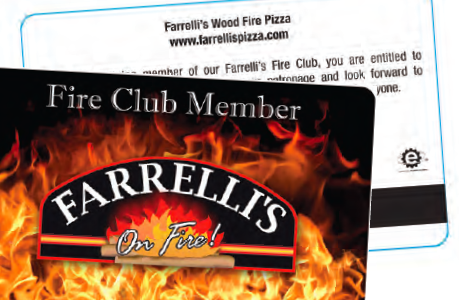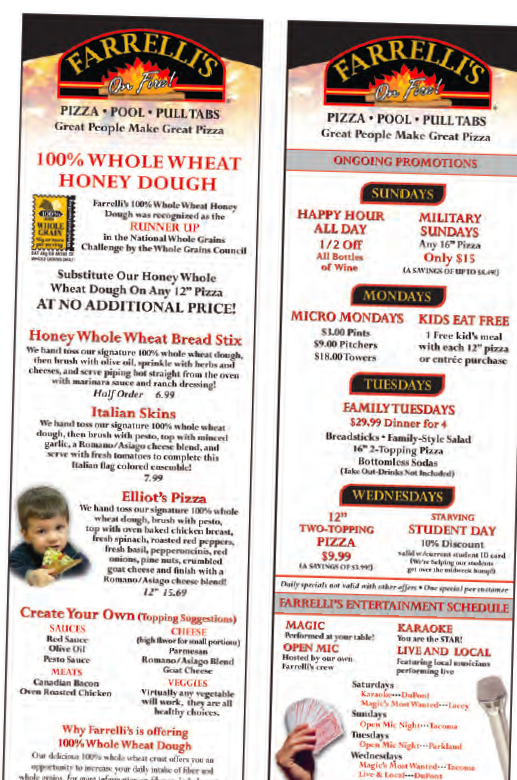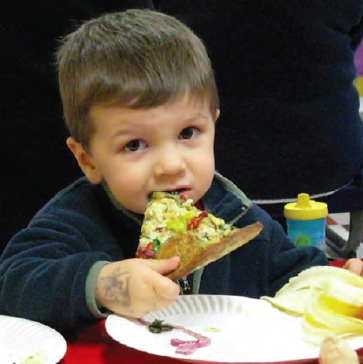 Serving up wood-fired pizzas to Washington’s Puget Sound region for more than 10 years, Farrelli’s Pizza (www.farrellispizza.com) boasts five locations and a growing “family” of employees. Clayton Krueger, Farrelli’s director of marketing and communications, tells PMQ about the company that hired him as a dishwasher at age 16, moved him up through every chef position in the kitchen until he left to pursue his college education, and then welcomed him back in 2007. “I’ve never worked for another company that operates with the mind-set that the employees come first; Farrelli’s success is the result of that mentality,” says Krueger.
Serving up wood-fired pizzas to Washington’s Puget Sound region for more than 10 years, Farrelli’s Pizza (www.farrellispizza.com) boasts five locations and a growing “family” of employees. Clayton Krueger, Farrelli’s director of marketing and communications, tells PMQ about the company that hired him as a dishwasher at age 16, moved him up through every chef position in the kitchen until he left to pursue his college education, and then welcomed him back in 2007. “I’ve never worked for another company that operates with the mind-set that the employees come first; Farrelli’s success is the result of that mentality,” says Krueger.
What have been some of your best marketing promotions, and why?
The best results we’ve seen have stemmed from customer loyalty marketing via direct mail and email, as well as the four walls that market inside our stores; both encourage customers to increase the frequency of their visits. While we don’t neglect trying to bring in new customers, we’ve found over the years that it’s easier and more effective to encourage our current customers to come back more often than it is to attract a new customer.
How much of your monthly budget is relegated to your marketing efforts?
Our marketing budget is based on a percentage of sales; we allocate roughly 2.5% of sales toward our marketing efforts.
How do you collect information from your customers for marketing?
As you know, knowledge is power, especially in the world of marketing. We attain our market-specific knowledge about our customers in a number of ways: 1) We have a customer loyalty program, which we have branded as our Fire Club—people sign up by submitting their information to us (they save 10% on their bill if they sign up during their visit), and in turn they receive various offers and incentives to visit our stores; 2) we’ve recently committed to an E-Frequency program through our POS system, which collects and maintains the data of our card-carrying loyal customers and stores it in a database for us to mine at our discretion; and 3) we have recently decided to undergo some market research in the form of focus group testing, as well as survey analysis, which will help us determine a lot of information about our clientele. Equally important as how you collect your customer’s data is how you use that data.
How often do you contact customers?
We reach our patrons in two ways: via email and via snail mail. We send out emails to our Fire Club members once to twice monthly with a special offer that only they receive. They also receive an email with a gift certificate on their birthday month, and in the anniversary month (when they signed up for our Fire Club). They also receive a gift certificate email when they sign up. As for the snail mail version, this is an extension of our direct mail effort; these folks receive a mail piece quarterly with a special offer that only they receive.
 How does your direct mail campaign work?
How does your direct mail campaign work?
This campaign is really a tier program. First, we are test marketing a new movers program, as well as a birthday mailer program. These pieces will directly target those individuals who meet the demographic criteria around our stores that have either just recently moved into our neighborhoods, or will be celebrating a birthday within the month. We are then signing up with a menu mailer company to produce and mail out a really professional menu that is well-branded with our company’s logo, values, products and staff. Finally, we are working on a letter that will introduce our business to the direct mail recipient in a way that explains to them why it is that our “Great People Make Great Pizza,” and will be a follow-up piece to the others. This last piece will have different incentives to get people to visit the store, in the form of coupons that we can track.
Do you advertise in any traditional media?
We recently found out that many of the major radio stations in the greater Seattle market have programs in which you trade gift certifi cates for airtime. They sell your gift certifi cates on their website for a reduced rate and in return promote your business on the air and through their website. This is an inexpensive way for us to test the radio waters and has been fairly successful at generating brand awareness. We’re continuing to pursue various programs on different radio stations and are tracking the results from each station; that way, we’ll know who to utilize for this purpose in the future. Perhaps, in the future, we will move toward television advertising, but we want to have a few more stores in a different geographical region before we do so. We have advertised in newspapers in the past and will continue to do so when we have something to share with the community but, for the most part, we have stopped our newspaper advertising efforts to focus on developing our people. We are also looking into Web advertising but haven’t committed to anything yet.
 How do you market to kids?
How do you market to kids?
We start by offering family meal deals and other promotions where kids can eat free with paying adults. We have a special kids menu, with kid pricing and items that you won’t find on our other menus. These menus also have fun drawings and puzzles that the kids can work on while they wait for their food, and we change the menus monthly to keep them fresh. We also have performers come in and entertain the kids on designated nights at our various stores. Currently, the entertainment we have for the kids is a pair of very talented magicians—so talented, in fact, that once they’re done entertaining the children, they move to the bar and entertain the adults.
How has having a full bar helped your bottom line?
The full bar has always been a part of the Farrelli’s business model and has doubled our bottom line because essentially operating two separate businesses under one roof with seamless integration and interaction between staff and customers. We’ve made changes to our bars over the years to increase their effectiveness, and we believe we’ve found the winning formula. First and foremost, we think of them as the adult only side of our restaurant—a place where adults can retreat from the excitement and noise of the children and families over on the restaurant side. Likewise, we think of our restaurant side as the family side of our establishment. The difference between viewing the different sides of our business as being adults and family vs. bar and restaurant has really helped to seamlessly integrate the two under one roof. Second, to support the strategy described above, we’ve added booth and table seating to our bars to make it a comfortable environment to eat a meal in, as well as socialize in—the result being higher ticket averages. The bars also feature pool tables and pull-tab games, and every seat faces at least one large flat panel television to view various sporting events.
How do you promote your happy hour menu to bring in more customers?
Our happy hour is offered seven days a week, from 2 to 6 p.m. and 9 p.m. to close, as well as all day on Sundays. Aside from that, it’s prominently displayed on the front cover of our bar menus and is also posted on our branded drink coasters. We list it on our regular menus, on our website, and on our MySpace page (www.myspace.com/farrellis), as well.
How do your pull-tab games work? Where did the idea come from?
Our current business model is the culmination of many past business models operated by the founder of Farrelli’s, John Farrell. He had experienced success at increasing the bottom line with pull tabs in his previous restaurant concepts, and we didn’t see any reason to omit them from the Farrelli’s concept, although it isn’t a primary focus. There’s a segment of the market that likes to gamble in the environment that we create inside of our bars, so we offer those individuals the opportunity to do so. Pull tabs are a numbers game, and we have to train our dealers well to keep those numbers in our favor. Sometimes they win and sometimes we win, but that’s the nature of gambling. If executed properly, pull tabs can be an easy way to generate real bottom-line results with low overhead.
How do you keep a low employee turnover?
We show our employees (we refer to them as Farrelli’s Family Members) that we value them in a number of ways, including, but not limited to, the following: 1) we pay more than the industry average; 2) we celebrate our success as a team; 3) we have many incentive programs; 4) we send our staff to different seminars and classes to increase their level of education and develop them as people; and 5) we take them on trips to industry-related trade shows. That’s the basic formula for our success; the result is a low turnover rate and a satisfied staff.
Has your MySpace page helped garner more attention for the restaurant? In what ways?
I don’t think that MySpace has helped to attract new customers so much as it’s helped us stay in communication with our current customers. As you know, MySpace is a social networking site, and we try hard to use it as such. When people, including our employees, are in our establishments, we work really hard to make them feel like they’re a part of our family. The idea behind MySpace is to allow them to experience that same feeling when they’re not here by giving them a forum to interact with staff as well as other customers, all while being exposed to our brand, our ongoing promotions, our entertainment schedule, and various other company-specific information. If for no other reason at all, we like MySpace for allowing us to promote our business and, more specifically, our upcoming events and promotions, to whoever wishes to listen.
When did you start offering whole-wheat dough? How are you marketing it to your customers?
We launched our 100% whole-wheat honey dough in September 2007, just prior to American Diabetes Month in November. We introduced the product to our customers with a new menu page, special recipes and special prices. We also attended several community diabetes events during the month of November to show the surrounding medical and diabetic communities that we are pioneering a new frontier of healthy/diabetic-friendly pizza. We were received very positively at these events, and the result was increased traffic to our stores. We’ve since shifted our focus from the product being a diabetic-friendly product to being a healthy alternative for anyone looking to enjoy a tasty slice of pizza while at the same time getting their daily intake of whole grains. The reaction has been positive, and we’re still working to spread the word about the product as a dietary option.
How do you interact with your community?
Part of our company’s mission is to nourish the communities in which we operate. We go about doing so by donating our time, products and efforts to multiple local charities, foundations and organizations in our communities. We participate in community groups, street fairs, parades and other events that bring our communities together. We do this because we live in these communities, too, so it really benefits all of us.
What is the best business advice you can pass on to other pizzeria owners?
As John would say, you need to “keep score,” meaning you must know your numbers as well as you know your people. Going one step further, your people should know your numbers, too. They must have set, attainable goals that they are striving to hit. This gives your employees buy-in and commitment. We give our employees incentives if they make their numbers, which encourages them all to take ownership and to be very conscious of the decisions that they make. The result is a committed staff and a very efficient operation. Keeping score is an essential part of our business model and should be an essential part of every restaurant owner’s operation.














